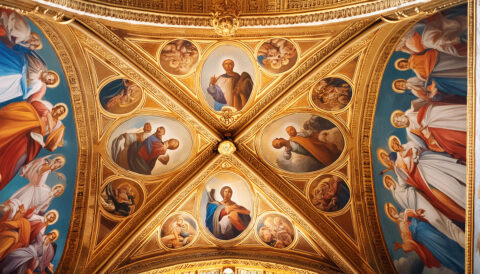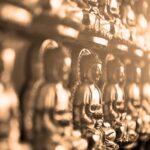Since the 14th to the 17th century, the Renaissance was a period in the history of Europe which saw great development in culture and art. The word “Renaissance” means “re-birth” and the period is named so because it was marked by renewed interest in ancient Greco-Roman culture. It started in Italy and spread across Europe leading to great changes in varied fields, which would have a profound and long-lasting effect on western civilization. During the Renaissance, art experienced radical and unprecedented development. Painters, sculptors, and architects whose masterpieces helped transform the world of art in an unique form that stuns the world still today.
The Italian Renaissance re-established Western art according to the principles of classical Greek art, sculpture and painting. From the early 14th century, in their search for a new set of artistic values and a response to the courtly International Gothic style, Italian artists and thinkers became inspired by the ideas and forms of ancient Greece and Rome. This was perfectly in tune with their desire to create a universal form of art which could express the new and more confident mood of the times. Above all, Renaissance art was driven by the new notion of “Humanism,” a philosophy which had been the foundation for many of the achievements of ancient Greece.
Italy had a huge repository of classical ruins and artifacts. Examples of Roman architecture were found in almost every town and city, and Roman sculpture, including copies of lost sculptures from ancient Greece, had been familiar for centuries. These factors help explain why the Renaissance started in Italy.
Some Famous Renaissance artist and their work
Cimabue (c.1240-1302) – Noted for his frescos at Assisi.
Giotto di Bondone (1267-1337) – Scrovegni Arena Chapel frescos.
Gentile da Fabriano (1370-1427) –Influential Gothic style painter.
Jacopo della Quercia (c.1374-1438) – Influential sculptor from Siena.
Lorenzo Ghiberti (1378-1455) – Sculptor of “Gates of Paradise”
Donatello (1386-1466) – Best early Renaissance sculptor
Paolo Uccello (1397-1475) – Famous for work on perspective.
Tommaso Masaccio (1401-1428) – Greatest early Florentine painter.
Piero della Francesca (1420-92) – Pioneer of linear perspective.
Andrea Mantegna (1430-1506) – Noted for illusionistic foreshortening techniques.
Donato Bramante (1444-1514) – Top High Renaissance architect.
Alessandro Botticelli (1445-1510) – Famous for mythological painting.
Leonardo da Vinci (1452-1519) – Creator of Mona Lisa, Last Supper.
Raphael (1483-1520) – Greatest High Renaissance painter.
Michelangelo (1475-1564) – Genius painter & sculptor.
Titian (1477-1576) – Greatest Venetian colourist.
Andrea del Sarto (1486-1530) – Leader of High Renaissance in Florence.
Correggio (1489-1534) – Famous for illusionistic quadratura frescoes.
Andrea Palladio (1508-80) – Dominated Venetian Renaissance architecture, later imitated in Palladianism.
Tintoretto (1518-1594) – Tintoretto was one of the three Venetian giants during the Renaissance.
Paolo Veronese (1528-1588) – Colourist follower of Titian.
Some of the artist that impacted the world with their work-
Sandro Botticelli (1445-1510) -He was a famous painter of the Florentinr School. His interest of painting was Greek mythology. Famous paintings are Birth of Venus, Primavera.
Leonardo Da vinci (1452-1519) – He was actually ‘The Renaissance Man’ inventor, engineer, painting, architecture he was a versatile genius of the age. Famous +work include Lady with Ermine, The Last Supper, Mona Lisa, Vitruvian Man.+
Michelangelo (1475-1564) – One of the finest sculptors of the world. His knowledge of human anatomy is noteworthy. The famous iconic David statue housed in Florence’s Galleria dell’Academia is an astonishing creation. He is famous for his frescoes, like the Sistine Chapel ceiling and the adjacent painting, The Last Judgment, which have been regarded as masterpieces for centuries. As an architect, he designed the great dome of St Peter’s Basilica in the Vatican.
Raphael (1482-1520)- Lived for only 37 years and he left a legacy of Italian architecture and painting. He also is famous for frescos and it is in the Vatican. Shool of Athens, Wedding of the Virgin are some famous works.
Titian (1488-1576) – He painted portraits to landscapes, mythological spectacles to biblical scenes. His dramatic yet lifelike style is uniquely reflected in his painting Using expressive brushstrokes, rich colors, and subtle contrast of light and shadow, he created some of the masterpieces. Famous work are Venus of Urbino, Bacchus and Ariadne
Tintoretto (1518-1594) – Tintoretto was one of the legend figures in the Venetian school of painting. He was a Mannerist painter. Famous Work – The Origin of the Milky Way, Vulcan Surprising Venus and Mars, Crucifixion, St Mark’s Body Brought to Venice
Donatello (1386-1466) – Donatello is one of the best-known sculptors of the Renaissance, He was born in Florence. His most famous piece, the bronze David.
Masaccio (1401-1428)- He was a Florentine artist who is regarded as the first great Italian painter of the Quattrocento period of the Italian Renaissance. Masaccio was one of the greatest painter of his generation because of his skill at imitating nature, recreating lifelike figures and movements as well as a convincing sense of three-dimensionality. Famous Work – Virgin and Child with Saint Anne, The Tribute Money, fresco in the Brancacci Chapel in Santa Maria del Carmine, Florence, Holy Trinity, in full: Trinity with the Virgin, Saint John the Evangelist, and Donors (c. 1427) – Fresco, Santa Maria Novella, Florence.
Giorgione (1470–1510) – He was an Italian painter of the Venetian school during the High Renaissance. His six surviving paintings feature atmospheric coloring, poetic qualities, and mysterious narratives. Giorgione’s most famous work, The Tempest, has been described as the first landscape in history due to the unprecedented prominence of the Italian countryside.
Giotto – (1267-1337) Italian painter of the 14th century. He was in the Early Renaissance period. The paintings of Giotto are known for being the first to masterfully capture the gestures, faces, sorrows and joys of human beings and for being faithful to nature. His fresco cycle on the Scrovegni Chapel is regarded as a supreme achievement of the Renaissance and one of the most important masterpieces in Western art. Famous Works : The Kiss of Judas , Ognissanti Madonna, Lamentation (The Mourning of Christ)
Reference :
https://learnodo-newtonic.com/famous-renaissance-artists
http://www.visual-arts-cork.com/renaissance-art.htm



